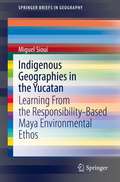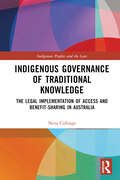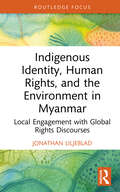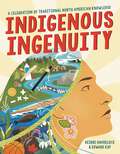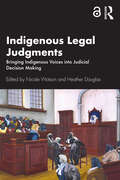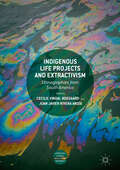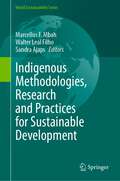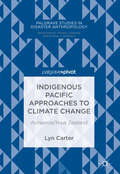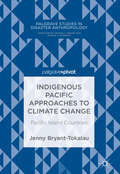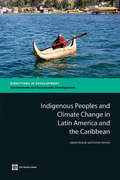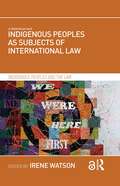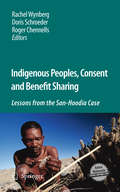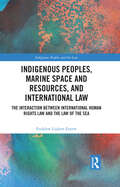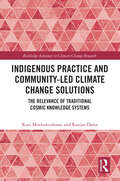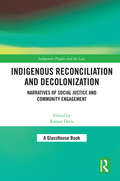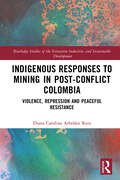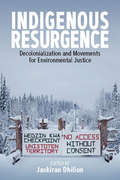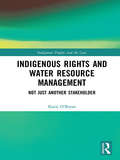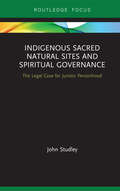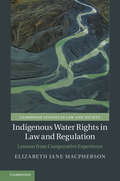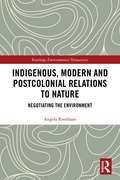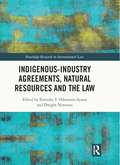- Table View
- List View
Indigenous Geographies in the Yucatan: Learning From the Responsibility-Based Maya Environmental Ethos (SpringerBriefs in Geography)
by Miguel SiouiThis book is part of a broader attempt to decolonize colonial histories and understandings about Indigenous peoples and their relationships with their territories, and argues that the land ethos of "being part of the land," specifically among the Mayan community of Xuilub (Yucatan), Mexico, is guided by the cultural precept of 'responsibility-based' thinking. The work uniquely adds much needed insights into 'responsibility-based' thinking for land-use practices, and develops a theoretical framework for assessing historical impacts on Indigenous cultures and livelihoods. In six chapters, the text bridges Western and Indigenous Knowledge (IK) approaches to achieve deeper understanding of IKs, focusing on more Indigenous-centered methods, with the goal of expanding the disciplinary perspectives of postcolonial scholarship and Indigenous geographies. The book contains useful information for environmental planning/management scholars and geographers who may not be familiar with Indigenous approaches to land-use, and to Indigenous geographers working to bridge Western and Indigenous methodologies.
Indigenous Governance of Traditional Knowledge: The Legal Implementation of Access and Benefit-Sharing in Australia (Indigenous Peoples and the Law)
by Neva CollingsThis book addresses the issue of Indigenous peoples' participation in genetic resource access and benefit-sharing and associated traditional knowledge for self-determination. Genetic resources from nature are increasingly used in global biodiscovery research and development, but they often use Indigenous peoples’ traditional knowledge without their consent and without sharing the benefit. The Nagoya Protocol is an instrument of the Convention on Biological Diversity intended to ensure Indigenous peoples’ traditional knowledge is used with their prior and informed consent or approval and entails benefit-sharing on mutually agreed terms. Many countries with significant Indigenous populations have signed the Nagoya Protocol and are currently grappling with implementation of its provisions. This book takes up a case study of Australia to demonstrate how Indigenous community governance in settler states can serve as a path to implementing the Nagoya Protocol. Australia’s access and benefitsharing framework is globally hailed as best practice, offering lessons for other countries implementing the Nagoya Protocol. Focusing on two Indigenous community organisations in Australia, the book establishes a unique evaluative framework for analysing and differentiating the governance arrangements used by Indigenous communities for facilitating decision-making related to traditional knowledge. This book will appeal to scholars working in the areas of international environmental law, human rights, biotechnology law, and Indigenous legal issues; as well as those directly engaged in implementing access and benefit-sharing measures and developing law reform strategies.
Indigenous Identity, Human Rights, and the Environment in Myanmar: Local Engagement with Global Rights Discourses (Routledge Focus on Environment and Sustainability)
by Jonathan LiljebladThis book draws on the experiences of the indigenous movement in Myanmar to explore how the local construction of indigenous identities connects communities to global mechanisms for addressing human rights and environmental issues. Various communities in Myanmar have increasingly adapted international discourses of indigenous identity as a vehicle to access international legal mechanisms to address their human rights and environmental grievances against the Myanmar state. Such exercise of global discourses overlays historical endemic struggles of diverse peoples involving intersectional issues of self- determination, cultural survival, and control over natural resources. This book draws implications for the intersectionality of local and global theoretical discourses of indigeneity, human rights, and environment. It uses such implications to identify attendant issues for the aspirations of international human rights and environmental efforts and the practice of their associated international legal mechanisms. This book informs readers of the agency and capabilities of communities in underdeveloped countries to engage different global mechanisms to address local grievances against their states. Readers will develop a more critical understanding of the issues posed by the local construction of indigeneity for the ideals and practice of international efforts regarding human rights and the environment. This book will be of great interest to students and scholars of indigenous studies, human rights, international law, Asian studies, development studies, and the environment.
Indigenous Ingenuity: A Celebration of Traditional North American Knowledge
by Edward Kay Deidre HavrelockCelebrate Indigenous thinkers and inventions with this beautifully designed, award-winning interactive nonfiction book—perfect for fans of Braiding Sweetgrass. <P><P>Corn. Chocolate. Fishing hooks. Boats that float. Insulated double-walled construction. Recorded history and folklore. Life-saving disinfectant. Forest fire management. Our lives would be unrecognizable without these, and countless other, scientific discoveries and technological inventions from Indigenous North Americans. Spanning topics from transportation to civil engineering, hunting technologies, astronomy, brain surgery, architecture, and agriculture, Indigenous Ingenuity is a wide-ranging STEM offering that answers the call for Indigenous nonfiction by reappropriating hidden history. <P><P>The book includes fun, simple activities and experiments that kids can do to better understand and enjoy the principles used by Indigenous inventors. Readers of all ages are invited to celebrate traditional North American Indigenous innovation, and to embrace the mindset of reciprocity, environmental responsibility, and the interconnectedness of all life.
Indigenous Legal Judgments: Bringing Indigenous Voices into Judicial Decision Making
by Nicole Watson and Heather DouglasThis book is a collection of key legal decisions affecting Indigenous Australians, which have been re-imagined so as to be inclusive of Indigenous people’s stories, historical experience, perspectives and worldviews. In this groundbreaking work, Indigenous and non-Indigenous scholars have collaborated to rewrite 16 key decisions. Spanning from 1889 to 2017, the judgments reflect the trajectory of Indigenous people’s engagements with Australian law. The collection includes decisions that laid the foundation for the wrongful application of terra nullius and the long disavowal of native title. Contributors have also challenged narrow judicial interpretations of native title, which have denied recognition to Indigenous people who suffered the prolonged impacts of dispossession. Exciting new voices have reclaimed Australian law to deliver justice to the Stolen Generations and to families who have experienced institutional and police racism. Contributors have shown how judicial officers can use their power to challenge systemic racism and tell the stories of Indigenous people who have been dehumanised by the criminal justice system. The new judgments are characterised by intersectional perspectives which draw on postcolonial, critical race and whiteness theories. Several scholars have chosen to operate within the parameters of legal doctrine. Some have imagined new truth-telling forums, highlighting the strength and creative resistance of Indigenous people to oppression and exclusion. Others have rejected the possibility that the legal system, which has been integral to settler-colonialism, can ever deliver meaningful justice to Indigenous people.
Indigenous Legal Judgments: Bringing Indigenous Voices into Judicial Decision Making
by Nicole Watson and Heather DouglasThis book is a collection of key legal decisions affecting Indigenous Australians, which have been re-imagined so as to be inclusive of Indigenous people’s stories, historical experience, perspectives and worldviews.In this groundbreaking work, Indigenous and non-Indigenous scholars have collaborated to rewrite 16 key decisions. Spanning from 1889 to 2017, the judgments reflect the trajectory of Indigenous people’s engagements with Australian law. The collection includes decisions that laid the foundation for the wrongful application of terra nullius and the long disavowal of native title. Contributors have also challenged narrow judicial interpretations of native title, which have denied recognition to Indigenous people who suffered the prolonged impacts of dispossession. Exciting new voices have reclaimed Australian law to deliver justice to the Stolen Generations and to families who have experienced institutional and police racism. Contributors have shown how judicial officers can use their power to challenge systemic racism and tell the stories of Indigenous people who have been dehumanised by the criminal justice system.The new judgments are characterised by intersectional perspectives which draw on postcolonial, critical race and whiteness theories. Several scholars have chosen to operate within the parameters of legal doctrine. Some have imagined new truth-telling forums, highlighting the strength and creative resistance of Indigenous people to oppression and exclusion. Others have rejected the possibility that the legal system, which has been integral to settler-colonialism, can ever deliver meaningful justice to Indigenous people.The Open Access version of this book, available at http://www.taylorfrancis.com, has been made available under a Creative Commons Attribution-Non Commercial-No Derivatives (CC-BY-NC-ND) 4.0 license.
Indigenous Life Projects and Extractivism: Ethnographies from South America (Approaches to Social Inequality and Difference)
by Cecilie Vindal Ødegaard Juan Javier Rivera AndíaExploring indigenous life projects in encounters with extractivism, the present open access volume discusses how current turbulences actualise questions of indigeneity, difference and ontological dynamics in the Andes and Amazonia. While studies of extractivism in South America often focus on wider national and international politics, this contribution instead provides ethnographic explorations of indigenous politics, perspectives and worlds, revealing loss and suffering as well as creative strategies to mediate the extralocal. Seeking to avoid conceptual imperialism or the imposition of exogenous categories, the chapters are grounded in the respective authors’ long-standing field research. The authors examine the reactions (from resistance to accommodation), consequences (from anticipation to rubble) and materials (from fossil fuel to water) diversely related to extractivism in rural and urban settings. How can Amerindian strategies to preserve localised communities in extractivist contexts contribute to ways of thinking otherwise?
Indigenous Methodologies, Research and Practices for Sustainable Development (World Sustainability Series)
by Walter Leal Filho Marcellus F. Mbah Sandra AjapsThis book states that whilst academic research has long been grounded on the idea of western or scientific epistemologies, this often does not capture the uniqueness of Indigenous contexts, and particularly as it relates to the achievement of the United Nations Sustainable Development Goals (SDGs). The SDGs were announced in 2015, accompanied by 17 goals and 169 targets. These goals are the means through which Agenda 2030 for sustainable development is to be pursued and realised over the next 15 years, and the contributions of Indigenous peoples are essential to achieving these goals.Indigenous peoples can be found in practically every region of the world, living on ancestral homelands in major cities, rainforests, mountain regions, desert plains, the arctic, and small Pacific Islands. Their languages, knowledges, and values are rooted in the landscapes and natural resources within their territories.However, many Indigenous peoples are now minorities within their homelands and globally, and there is a dearth of research based on Indigenous epistemologies and methodologies. Furthermore, academic research on Indigenous peoples is typically based on western lenses. Thus, the paucity of Indigenous methodologies within mainstream research discourses present challenges for implementing practical research designs and interpretations that can address epistemological distinctiveness within Indigenous communities.There is therefore the need to articulate, as well as bring to the nexus of research aimed at fostering sustainable development, a decolonising perspective in research design and practice.This is what this book wants to achieve. The contributions critically reflect on Indigenous approaches to research design and implementation, towards achieving the sustainable development goals, as well as the associated challenges and opportunities. The contributions also advanced knowledge, theory, and practice of Indigenous methodologies for sustainable development.
Indigenous Pacific Approaches to Climate Change: Aotearoa/New Zealand (Palgrave Studies in Disaster Anthropology)
by Lyn CarterSituating Māori Ecological Knowledge (MEK) within traditional environmental knowledge (TEK) frameworks, this book recognizes that indigenous ecological knowledge contributes to our understanding of how we live in our world (our world views), and in turn, the ways in which humans adapt to climate change. As an industrialized nation, Aotearoa/New Zealand (A/NZ) has responsibilities and obligations to other Pacific dwellers, including its indigenous populations. In this context, this book seeks to discuss how A/NZ can benefit from the wider Pacific strategies already in place; how to meet its global obligations to reducing GHG; and how A/NZ can utilize MEK to achieve substantial inroads into adaptation strategies and practices. In all respects, Māori tribal groups here are well-placed to be key players in adaptation strategies, policies, and practices that are referenced through Māori/Iwi traditional knowledge.
Indigenous Pacific Approaches to Climate Change: Pacific Island Countries
by Jenny Bryant-TokalauThis book explores how Pacific Island communities are responding to the challenges wrought by climate change—most notably fresh water accessibility, the growing threat of disease, and crop failure. The Pacific Island nations are not alone in facing these challenges, but their responses are unique in that they arise from traditional and community-based understandings of climate and disaster. Knowledge sharing, community education, and widespread participation in decision-making have promoted social resilience to such challenges across the Pacific. In this exploration of the Pacific Island countries, Bryant-Tokalau demonstrates that by understanding the inter-relatedness of local expertise, customary resource management, traditional knowledge and practice, as well as the roles of leaders and institutions, local “knowledge-practice-belief systems” can be used to inform adaptation to disasters wherever they occur.
Indigenous Peoples and Climate Change in Latin America and the Caribbean
by Dorte Verner Jakob KronikThis book addresses the social implications of climate change and climatic variability on indigenous peoples and communities living in the highlands, lowlands, and coastal areas of Latin America and the Caribbean. Across the region, indigenous people already perceive and experience negative effects of climate change and variability. Many indigenous communities find it difficult to adapt in a culturally sustainable manner. In fact, indigenous peoples often blame themselves for the changes they observe in nature, despite their limited emission of green house gasses. Not only is the viability of their livelihoods threatened, resulting in food insecurity and poor health, but also their cultural integrity is being challenged, eroding the confidence in solutions provided by traditional institutions and authorities. The book is based on field research among indigenous communities in three major eco-geographical regions: the Amazon; the Andes and Sub-Andes; and the Caribbean and Mesoamerica. It finds major inter-regional differences in the impacts observed between areas prone to rapid- and slow-onset natural hazards. In Mesoamerican and the Caribbean, increasingly severe storms and hurricanes damage infrastructure and property, and even cause loss of land, reducing access to livelihood resources. In the Columbian Amazon, changes in precipitation and seasonality have direct immediate effects on livelihoods and health, as crops often fail and the reproduction of fish stock is threatened by changes in the river ebb and flow. In the Andean region, water scarcity for crops and livestock, erosion of ecosystems and changes in biodiversity threatens food security, both within indigenous villages and among populations who depend on indigenous agriculture, causing widespread migration to already crowded urban areas. The study aims to increase understanding on the complexity of how indigenous communities are impacted by climate change and the options for improving their resilience and adaptability to these phenomena. The goal is to improve indigenous peoples' rights and opportunities in climate change adaptation, and guide efforts to design effective and sustainable adaptation initiatives.
Indigenous Peoples and Climate Justice: A Critical Analysis of International Human Rights Law and Governance (Energy, Climate and the Environment)
by Giada GiacominiThis book provides a new interpretation of international law specifically dedicated to Indigenous peoples in the context of a climate justice approach. The book presents a critical analysis of past and current developments at the intersection of human rights and international environmental law and governance. The book suggests new ways forward and demonstrates the need for a paradigmatic shift that would enhance the meaningful participation of Indigenous peoples as fundamental actors in the conservation of biodiversity and in the fight against climate change. The book offers guidance on a number of critical intersecting and interdependent issues at the forefront of climate change law and policy – inside and outside of the UN climate change regime. The author suggests that the adoption of a critical perspective on international law is needed in order to highlight inherent structural and systemic issues of the international law regime which are all issues that ultimately impede the pursue of climate justice for Indigenous peoples.
Indigenous Peoples as Subjects of International Law (Indigenous Peoples and the Law)
by Irene WatsonFor more than 500 years, Indigenous laws have been disregarded. Many appeals for their recognition under international law have been made, but have thus far failed – mainly because international law was itself shaped by colonialism. How, this volume asks, might international law be reconstructed, so that it is liberated from its colonial origins?With contributions from critical legal theory, international law, politics, philosophy and Indigenous history, this volume pursues a cross-disciplinary analysis of the international legal exclusion of Indigenous Peoples, and of its relationship to global injustice. Beyond the issue of Indigenous Peoples’ rights, however, this analysis is set within the broader context of sustainability; arguing that Indigenous laws, philosophy and knowledge are not only legally valid, but offer an essential approach to questions of ecological justice and the co-existence of all life on earth.The Open Access version of this book, available at http://www.taylorfrancis.com, has been made available under a Creative Commons (CC-BY-NC-ND) 4.0 license.
Indigenous Peoples, Consent and Benefit Sharing: Lessons from the San-Hoodia Case
by Doris Schroeder Rachel Wynberg Roger ChennellsIndigenous Peoples, Consent and Benefit Sharing is the first in-depth account of the Hoodia bioprospecting case and use of San traditional knowledge, placing it in the global context of indigenous peoples' rights, consent and benefit-sharing. It is unique as the first interdisciplinary analysis of consent and benefit sharing in which philosophers apply their minds to questions of justice in the Convention on Biological Diversity (CBD), lawyers interrogate the use of intellectual property rights to protect traditional knowledge, environmental scientists analyse implications for national policies, anthropologists grapple with the commodification of knowledge and, uniquely, case experts from Asia, Australia and North America bring their collective expertise and experiences to bear on the San-Hoodia case.
Indigenous Peoples, Marine Space and Resources, and International Law: The Interaction Between International Human Rights Law and the Law of the Sea (ISSN)
by Endalew Lijalem EnyewThis book addresses the rights of indigenous peoples to marine space and associated marine resources under international law.Examining the rights of indigenous peoples relating to marine space and marine resources both in international human rights law and the law of the sea, the book provides an in-depth critical analysis of the existing legal framework, whilst identifying the gaps, and possible further mechanisms, for recognizing the rights of indigenous peoples to marine space. The book addresses three main issues: 1) the extent to which international law recognizes and protects the rights of indigenous peoples in relation to marine space and marine resources; 2) if and how the law of the sea and international human rights law pertaining to the rights of indigenous peoples to marine space and marine resources interact; 3) whether and to what extent the law of the sea regime limits the capacity of coastal States to recognize and implement the rights of indigenous peoples relating to marine space and resources. In response, and in a context where indigenous marine rights are under increasing threat, the book develops an important critical theoretical and methodological approach which moves beyond the current doctrinal focus of much existing work in this area.The book will appeal to academics, researchers, and practitioners in the areas of indigenous peoples and the law, international law, the law of the sea, and human rights.
Indigenous Practice and Community-Led Climate Change Solutions: The Relevance of Traditional Cosmic Knowledge Systems (Routledge Advances in Climate Change Research)
by Ranjan Datta Rani MuthukrishnanThis book centers Indigenous knowledge and practice in community-led climate change solutions. This book will be one of the first academic books to use the consciousness framework to examine and explain humans' situatedness and role in maintaining ecosystems' health. Drawing on teachings from the Indigenous Adi-Shaiva community, the authors present up-to-date research on meanings and implications of South Asian traditional cosmic knowledge, which focuses on relationality and spirituality connected to climate change. This knowledge can create innovative climate change solutions in areas including land, water, traditional management, sustainability goals and expectations, and state development projects. Overall, this book provides an innovative framework for nonviolent climate solutions, which has its foundations in a traditional cosmic and consciousness-based context. This book, which aims to bridge the gap between Indigenous and Western perspectives by re-educating researchers and decolonizing popular climate change solutions, will be of great interest to students and scholars studying climate change, conservation, environmental anthropology, and Indigenous studies on a broader scale.
Indigenous Practice and Community-Led Climate Change Solutions: The Relevance of Traditional Cosmic Knowledge Systems (Routledge Advances in Climate Change Research)
by Ranjan Datta Rani MuthukrishnanThis book centers Indigenous knowledge and practice in community-led climate change solutions.This book will be one of the first academic books to use the consciousness framework to examine and explain humans' situatedness and role in maintaining ecosystems' health. Drawing on teachings from the Indigenous Adi-Shaiva community, the authors present up-to-date research on meanings and implications of South Asian traditional cosmic knowledge, which focuses on relationality and spirituality connected to climate change. This knowledge can create innovative climate change solutions in areas including land, water, traditional management, sustainability goals and expectations, and state development projects. Overall, this book provides an innovative framework for nonviolent climate solutions, which has its foundations in a traditional cosmic and consciousness-based context.This book, which aims to bridge the gap between Indigenous and Western perspectives by re-educating researchers and decolonizing popular climate change solutions, will be of great interest to students and scholars studying climate change, conservation, environmental anthropology, and Indigenous studies on a broader scale.
Indigenous Reconciliation and Decolonization: Narratives of Social Justice and Community Engagement (Indigenous Peoples and the Law)
by Ranjan DattaThis book addresses the ethical and practical issues at stake in the reconciliation of Indigenous and non-indigenous communities. An increasing number of researchers, educators, and social and environmental activists are eager to find ways to effectively support ongoing attempts to recognize, integrate and promote Indigenous perspectives and communities. Taking Canada as its focus, this book offers a multidisciplinary consideration of a range of reconciliation policies, practices and initiatives that are relevant in all settler states. Set against its increasing neoliberal appropriation, the book resituates reconciliation in the everyday contexts of community interaction and engagement, as well as in the important areas of Indigenous knowledge, resource management and social and environmental justice. Reconciliation is not just the responsibility of law and government. And, attuned to the different perspectives of settlers, migrants and refugee communities, the book examines areas of opportunity, as well as obstacles to progress, in the forging of a truly decolonizing framework for reconciliation. As the challenges of reconciliation cross numerous academic and substantial areas, this book will appeal to a range of scholars and practitioners working in law, politics, education, environmental studies, anthropology and Indigenous studies.
Indigenous Responses to Mining in Post-Conflict Colombia: Violence, Repression and Peaceful Resistance (Routledge Studies of the Extractive Industries and Sustainable Development)
by Diana Carolina Arbeláez RuizThis book examines Indigenous responses to mining and their connection to peacebuilding, focusing on the experience of the Nasa Indigenous people of North Cauca during the most recent Colombian post-agreement transition. Amid an armed conflict that has disproportionally affected and targeted the Nasa, as well as ongoing processes of dispossession and oppression, the Nasa have built a tradition of organised, peaceful resistance. This book examines the nature of their responses to mining and how this is linked to peacebuilding, with a focus on how resistance is shaped and enacted to respond to the relationship mineral extraction has with violence and peace. The work is exploratory, ethnographic and interdisciplinary in nature, sitting in the intersection between the anthropology of mining, development studies and peace and conflict studies. The author presents and analyses narratives, participant responses, and her own experiences to illustrate the context and interconnected processes shaping Nasa responses to mining during this transition period. The book will bring international readers closer to these intricate dynamics, where access is otherwise limited because of security, cultural, linguistic and other barriers. The book provides a novel perspective on post-conflict mining governance by focusing on the Nasa’s active role in responding to mining in a post-agreement, transitional context. It highlights, and encourages engagement with, the often-overlooked role of morality in debates about nature and development. This book will be of great interest to students, scholars and practitioners of the extractive industries, natural resource management, conflict management and peacebuilding, Indigenous Peoples and Latin American studies.
Indigenous Resurgence: Decolonialization and Movements for Environmental Justice
by Jaskiran DhillonFrom the Standing Rock Sioux Tribe’s resistance against the Dakota Access pipeline to the Nepalese Newar community’s protest of the Fast Track Road Project, Indigenous peoples around the world are standing up and speaking out against global capitalism to protect the land, water, and air. By reminding us of the fundamental importance of placing Indigenous politics, histories, and ontologies at the center of our social movements, Indigenous Resurgence positions environmental justice within historical, social, political, and economic contexts, exploring the troubling relationship between colonial and environmental violence and reframing climate change and environmental degradation through an anticolonial lens.
Indigenous Rights and Water Resource Management: Not Just Another Stakeholder (Indigenous Peoples and the Law)
by Katie O'BryanIn an era of climate change, the need to manage our water resources effectively for future generations has become an increasingly significant challenge. Indigenous management practices have been successfully used to manage inland water systems around the world for thousands of years, and Indigenous people have been calling for a greater role in the management of water resources. As First Peoples and as holders of important knowledge of sustainable water management practices, they regard themselves as custodians and rights holders, deserving of a meaningful role in decision-making. This book argues that a key (albeit not the only) means of ensuring appropriate participation in decision-making about water management is for such participation to be legislatively mandated. To this end, the book draws on case studies in Australia and New Zealand in order to elaborate the legislative tools necessary to ensure Indigenous participation, consultation and representation in the water management landscape.
Indigenous Sacred Natural Sites and Spiritual Governance: The Legal Case for Juristic Personhood (Routledge Focus on Environment and Sustainability)
by John StudleySince time immemorial indigenous people have engaged in legal relationships with other-than-human-persons. These relationships are exemplified in enspirited sacred natural sites, which are owned and governed by numina spirits that can potentially place legal demands on humankind in return for protection and blessing. Although conservationists recognise the biodiverse significance of most sacred natural sites, the role of spiritual agency by other-than-human-persons is not well understood. Consequently, sacred natural sites typically lack legal status and IUCN-designated protection. More recent ecocentric and posthuman worldviews and polycentric legal frameworks have allowed courts and legislatures to grant 'rights' to nature and 'juristic personhood' and standing to biophysical entities. This book examines the indigenous literature and recent legal cases as a pretext for granting juristic personhood to enspirited sacred natural sites. The author draws on two decades of his research among Tibetans in Kham (southwest China), to provide a detailed case study. It is argued that juristic personhood is contingent upon the presence and agency of a resident numina and that recognition should be given to their role in spiritual governance over their jurisdiction. The book concludes by recommending that advocacy organisations help indigenous people with test cases to secure standing for threatened sacred natural sites (SNS) and calls upon IUCN, UNESCO (MAB and WHS), ASEAN Heritage and EuroNatura to retrospectively re-designate their properties, reserves, parks and initiatives so that SNS and spiritual governance are fully recognised and embraced. It will be of great interest to advanced students and researchers in environmental law, nature conservation, religion and anthropology.
Indigenous Water Rights in Law and Regulation: Lessons from Comparative Experience (Cambridge Studies in Law and Society)
by Elizabeth Jane MacphersonIndigenous Water Rights in Law and Regulation responds to an unresolved question in legal scholarship: how are (or how might be) indigenous peoples' rights included in contemporary regulatory regimes for water. This book considers that question in the context of two key trajectories of comparative water law and policy. First, the tendency to 'commoditise' the natural environment and use private property rights and market mechanisms in water regulation. Second, the tendency of domestic and international courts and legislatures to devise new legal mechanisms for the management and governance of water resources, in particular 'legal person' models. This book adopts a comparative research method to explore opportunities for accommodating indigenous peoples' rights in contemporary water regulation, with country studies in Australia, Aotearoa New Zealand, Chile and Colombia, providing much needed attention to the role of rights and regulation in determining indigenous access to, and involvement with, water in comparative law.
Indigenous, Modern and Postcolonial Relations to Nature: Negotiating the Environment (Routledge Environmental Humanities)
by Angela RoothaanIndigenous, Modern and Postcolonial Relations to Nature contributes to the young field of intercultural philosophy by introducing the perspective of critical and postcolonial thinkers who have focused on systematic racism, power relations and the intersection of cultural identity and political struggle. Angela Roothaan discusses how initiatives to tackle environmental problems cross-nationally are often challenged by economic growth processes in postcolonial nations and further complicated by fights for land rights and self-determination of indigenous peoples. For these peoples, survival requires countering the scramble for resources and clashing with environmental organizations that aim to bring their lands under their own control. The author explores the epistemological and ontological clashes behind these problems. This volume brings more awareness of what structurally obstructs open exchange in philosophy world-wide, and shows that with respect to nature, we should first negotiate what the environment is to us humans, beyond cultural differences. It demonstrates how a globalizing philosophical discourse can fully include epistemological claims of spirit ontologies, while critically investigating the exclusive claim to knowledge of modern science and philosophy. This book will be of great interest to students and scholars of environmental philosophy, cultural anthropology, intercultural philosophy and postcolonial and critical theory.
Indigenous-Industry Agreements, Natural Resources and the Law (Routledge Research in International Law)
by Dwight Newman Ibironke T. Odumosu-AyanuThis edited collection is an interdisciplinary and international collaborative book that critically investigates the growing phenomenon of Indigenous-industry agreements – agreements that are formed between Indigenous peoples and companies involved in the extractive natural resource industry. These agreements are growing in number and relevance, but there has yet to be a systematic study of their formation and implementation. This groundbreaking collection is situated within frameworks that critically analyze and navigate relationships between Indigenous peoples and the extraction of natural resources. These relationships generate important questions in the context of Indigenous-industry agreements in diverse resource-rich countries including Australia and Canada, and regions such as Africa and Latin America. Beyond domestic legal and political contexts, the collection also interprets, navigates, and deploys international instruments such as the United Nations Declaration on the Rights of Indigenous Peoples in order to fully comprehend the diverse expressions of Indigenous-industry agreements. Indigenous-Industry Agreements, Natural Resources and the Law presents chapters that comprehensively review agreements between Indigenous peoples and extractive companies. It situates these agreements within the broader framework of domestic and international law and politics, which define and are defined by the relationships between Indigenous peoples, extractive companies, governments, and other actors. The book presents the latest state of knowledge and insights on the subject and will be of value to researchers, academics, practitioners, Indigenous communities, policymakers, and students interested in extractive industries, public international law, Indigenous rights, contracts, natural resources law, and environmental law.
